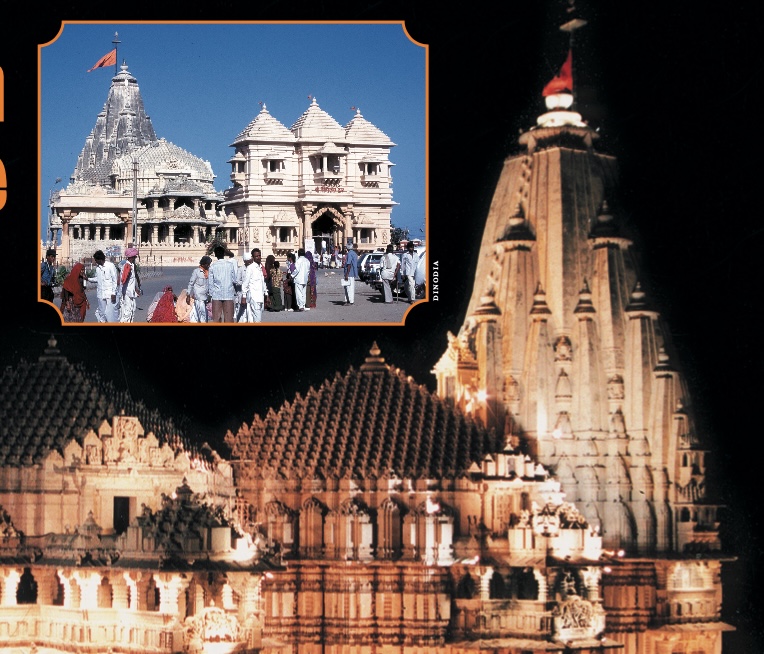By Priyank Jaiswal
I first learned about Somnath through my study of history in school. That’s also about when I became interested in Hindu mythology, where again I ran across references to this fascinating pilgrimage destination of great importance to Saivite Hindus. All my life, I have read, thought and wondered about Somnath. Last summer, 2002, I finally got to go there.
The temple of Somnath is in the city of Prabhas-Patan in Gujarat. I planned my pilgrimage so that I would approach the temple by road from Dwarka along the coast of the Arabian Sea. I arrived on a clear, sunny day during the full-moon time of the month when strong, spring tides come crashing in upon the shores. I will never forget those first impressions. It was like a drama. As I entered Patan, I became lost in a maze of streets lined with shops. I walked and walked. Suddenly, I was there. Glittering like gold in the afternoon sun, the temple was even more beautiful than I had anticipated. With the seascape thundering behind, the view was mesmerizing. I was in awe.
Just in front of the temple, a majestic gateway rose like a fortress. Everywhere there were ornate designs and human figures carved in stone. It was all so powerful and lifelike. Yet it was the hundreds of pillars that took my breath away. Sprawling like the roots of a giant banyan or the legs of some great beast, they seemed to bind to Earth this grand temple of otherworldly beauty.
It was all I could do to just stand there, staring. For the longest time, I was simply immersed in the recollection of all the many fables I had heard and read. I purposely let my imagination run wild, trying to catch fleeting mental glimpses of the great temples that had come and gone on this most holy ground.
The history of Somnath is brutal. Seven times it was destroyed and seven times it was born again. Muhammad of Ghazini first ransacked the sacred abode on January 6, 1026. Fifty thousand Saivites laid down their lives in that battle. But Muhammad won the war, captured the city and looted the temple before crushing it to the ground. This was a tragic loss mourned by many, for that first Somnath temple was a magnificently crafted, red sandstone work of art, acclaimed as one of the great architectural accomplishments of its age.
Immediately, however, the temple was renovated by King Bhima of Gujarat and King Bhoja of Malwa. When it was again destroyed in 1300 by Alaf Khan, King Mahipala of the Chudasama dynasty rebuilt it. Three times more in 1390, 1490 and 1530 it was destroyed and reconstructed.
After the great Siva temple was demolished one final time in 1706, nearly 250 years would pass before it would again rise from the grave. This seventh reincarnation of Somnath was commenced in 1950 following India’s independence. Sardar Vallabhai Patel, the first Deputy Prime Minister of India, had the temple reconstructed in the Chalukya style of temple architecture by master masons of Gujarat called sompuras. When this last rebuilding effort was completed on December 1, 1995, 45 years after it began, the first president of India, Shankar Dayal Sharma, renamed it Kailash Mahameru Prasada. Such a temple, he said, had not been constructed in India for 800 years.
Finally, I brought myself back to Earth and was ready to continue myworship. Depositing my camera and shoes, I entered the temple complex through the towering gateway. As on any other day, the temple was crowded with visitors from all around the world. At 11:00 in the morning the day’s main puja (ceremony) began. When the doors of the sanctum opened, devotees began rushing forward. In no time, the place was packed.
The chanting of the mantras, the smell of the incense and the incoherent murmur of the crowd had suddenly turned this quiet sanctuary by the sea into an energized vortex of spiritual power. At the conclusion of the puja, devotees started crushing their way toward the sanctum to receive holy prashad (sacraments). After about half an hour, I was finally able to actually see the lingam. This did not last long. Yet even as the crowd was pushing me on, I felt the inrush of a great and powerful force.
I had traveled half way around the globe for this experience. Even that short moment of deep communion was enough to mold in me a memory that would never die. Having seen what I had yearned to see since childhood, I now felt an overwhelming sense of deep satisfaction.
The PashupatasÑan ancient sect of powerful Siva worshipersÑwere living in Prabhas when the first Somnath temple was constructed. Historians claim they had been there since prehistory, establishing that geographical portion of India as an important stronghold of unshakable Siva worship. The seven triala of Somneath seem to validate this speculation. The very air there breathes a fortitude and dedication.
Today, like some grand invincible warrior, seven times victorious in battle, Somnath once again stands strong for Sivaon the shores of Prabhas. Anyone who knowsevena little of the history and magic of this holy place will understand why it is called “The Shrine Eternal”.
